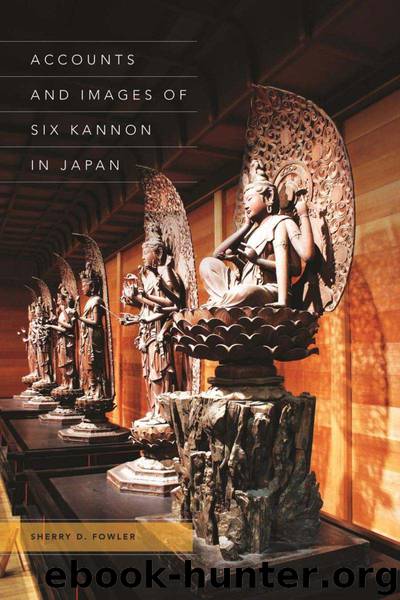Accounts and Images of Six Kannon in Japan by Sherry D. Fowler

Author:Sherry D. Fowler [Fowler, Sherry D.]
Language: eng
Format: azw3
ISBN: 9780824856243
Publisher: University of Hawaii Press
Published: 2016-11-30T05:00:00+00:00
The number was likely adopted from traditional concepts of the Hindu or Vedic pantheon, which consists of thirty-three different gods, evenly divided into three groups of eleven. These groups preside over three different categories of responsibility: atmospheric, terrestrial, and celestial.4 Thus, the number thirty-three was an auspicious choice for the number of guises as a representative of a large powerful assembly. The number is also associated with the Heaven of the Thirty-Three Gods (J. Tōriten; Skt. Trāyastriṃśa), which according to Buddhist cosmology, is on the peak of Mount Sumeru, where the Vedic and Hindu gods who converted to Buddhism live.5 Since there are an infinite number of Kannon manifestations and an infinite number of deities who live on the peak of Mount Sumeru, the number thirty-three seems to stand for the idea of a great number with venerable roots in earlier Hindu or Vedic cosmology, rather than an accurate calculation. Other numbers that often stand in for “a lot” are 100 or 10,000 and 84,000, but they do not have the special resonance that thirty-three has with Kannon.
Illustrations from the Lotus sūtra that emphasize the Guanyin chapter in China appear as early as the fifth century and became increasingly popular afterward, with many made throughout the Tang dynasty (618–907).6 One of the earliest Chinese portable examples in which the guises appear is the painted booklet (10 × 18 cm) of the Guanyinjing (Kannon sūtra) made in the late ninth to tenth century and found at Dunhuang. This booklet, which is part of the Stein Collection (S. 6983) now kept at the British Library, consists of simple black outline pictures with accents of orange and red above the accompanying sutra text.7 To further abbreviate, the artist grouped some of the guises together on a single page. In Figure 6.2 the text on the right page may be translated as “If they need a chief minister to be saved, immediately he becomes a chief minister and preaches the Law for them.”8 The illustration shows a minister preaching to two others. On the left page the text states, “If they need a Brahman to be saved, immediately he becomes a Brahman and preaches the Law for them. If they need a monk, a nun, a layman believer, or a laywoman believer to be saved, immediately he becomes a monk, a nun, a layman believer, or a laywoman believer and preaches the Law for them.”9 The scene shows a monk preaching to a layman and laywoman, and next to him is a Brahman facing the other way, who seems to be preaching to a minister on the facing page. Such simple booklets could easily have made their way to Japan as an avenue of iconographic transmission.
FIGURE 6.2. Guanyin sūtra (J. Kannongyō) found at Dunhuang. Ninth–tenth century. Illustrated manuscript bound as a booklet. Ink and color on paper. 8 × 10 cm. © The British Library Board, Or.8210/S.6983.
Download
This site does not store any files on its server. We only index and link to content provided by other sites. Please contact the content providers to delete copyright contents if any and email us, we'll remove relevant links or contents immediately.
| Africa | Americas |
| Arctic & Antarctica | Asia |
| Australia & Oceania | Europe |
| Middle East | Russia |
| United States | World |
| Ancient Civilizations | Military |
| Historical Study & Educational Resources |
The Rape of Nanking by Iris Chang(3507)
The Sympathizer by Viet Thanh Nguyen(3461)
World without end by Ken Follett(3003)
Ants Among Elephants by Sujatha Gidla(2920)
Blood and Sand by Alex Von Tunzelmann(2606)
Japanese Design by Patricia J. Graham(2552)
City of Djinns: a year in Delhi by William Dalrymple(2130)
Inglorious Empire by Shashi Tharoor(2098)
Foreign Devils on the Silk Road: The Search for the Lost Treasures of Central Asia by Peter Hopkirk(2052)
In Order to Live: A North Korean Girl's Journey to Freedom by Yeonmi Park(2049)
Tokyo by Rob Goss(2014)
India's Ancient Past by R.S. Sharma(1982)
India's biggest cover-up by Dhar Anuj(1978)
The Great Game: On Secret Service in High Asia by Peter Hopkirk(1959)
Tokyo Geek's Guide: Manga, Anime, Gaming, Cosplay, Toys, Idols & More - The Ultimate Guide to Japan's Otaku Culture by Simone Gianni(1941)
Goodbye Madame Butterfly(1930)
The Queen of Nothing by Holly Black(1748)
Living Silence in Burma by Christina Fink(1726)
Batik by Rudolf Smend(1718)
